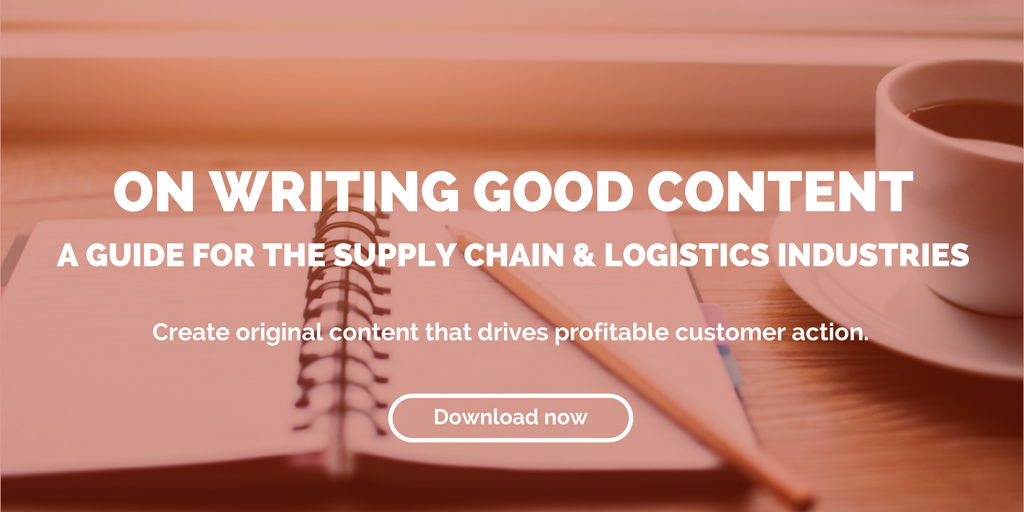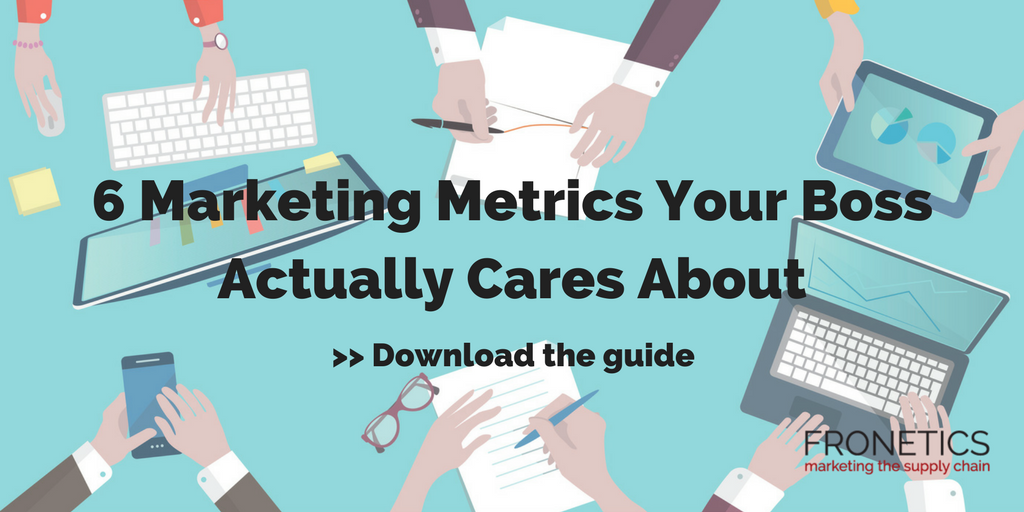
by Fronetics | Jul 12, 2018 | Blog, Content Marketing, Logistics, Marketing, Supply Chain
Meta descriptions help boost your SEO, driving more traffic to your posts and more quality leads on your website.
You’re trying your best to become an expert in SEO optimization. You’re working hard to create valuable content, finding visually pleasing images to accompany your posts (and adding alt text), and using internal and external links throughout. But many of us marketers fail to acknowledge the importance of a strong, interesting meta description.
What is a meta description?
According to Wordstream, a meta description (sometimes called a meta description attribute or tag) is an HTML element that describes and summarizes the contents of your page for the benefit of users and search engines. Broken down into laymen’s terms, this means that meta descriptions are a short snippet of text that appears on a search engine results page (SERP) under your page title to describe to readers exactly what your content is about.
Why are meta descriptions important?
A strong meta description can draw visitors to your content. As they scroll through organic search results, your meta description is their first glance at what they can expect from your page, making it a very visible part of search marketing. A compelling meta description gives you a brief overview of what the content is about, as well as a convincing reason to click on the link to your page.
[bctt tweet=”As visitors scroll through organic search results, your meta description is their first glance at what they can expect from your page, making it a very visible part of search marketing. ” username=”Fronetics”]
Sounds pretty simple, right? Writing persuasive meta descriptions can actually be quite challenging.
The character-count limit, which depends on your content management platform, keeps your descriptions to not much longer than a tweet. It’s a lot of pressure for marketers to come up with short but captivating snippets as to why a reader should click on your page. Hence why most marketers tend to glance over this key factor in SEO optimization.
Here are five tips to help you start writing better meta descriptions and increasing your click-through rates quickly.
5 tips for writing better meta descriptions
1. Keep it to 155 characters.
According to Moz’s research team, the optimal character length for meta descriptions is 150-160 characters. Anything longer and most search engines will cut off your description.

As you can see above, longer descriptions that get cut off don’t give readers a full picture of what your page is about. It’s important to keep to the optimal character count, giving readers a clear understanding of why they need to visit your page.
2. Read, read, and read again: no grammatical errors.
This seems pretty straight forward, but grammatical errors in a short description are bad. Really bad. Make sure you go back and read (and reread) your meta descriptions before you post them. And don’t be afraid to ask your coworkers to double check your work — sometimes it’s hard to see errors in your own writing. Your descriptions are a direct reflection of your content and therefore need to be flawless.
3. Don’t shy away from offers.
We’ve all seen a meta description that adds “30-day trail free” at the end. And why not? Essentially, a meta description is a hook for visitors to click on your page. Incentives are a great way to help your page stand out from the competition. Including short call-to-actions or offers in your description lets visitors know what’s waiting for them when they visit your site. It’s a great way to boost your content and get the most value from your meta descriptions.
4. Beware of Google AdWords.
Google AdWords is a form of paid advertising that prioritizes paid ads over organic search results. This is great if you’re paying for advertising. But if you’re like many marketers, you’re hoping to be at the top of the search results because you’re working hard to optimize your content. Because Google now posts the top four search results through AdWords, your content has to work harder to get to the top of the search results lists, making your meta descriptions more important than ever.
Focus on writing descriptions that provide value and invite readers to click on your site, other than trying to sell yourself. A more natural, inviting meta description will help you stand out against the paid ads also appearing in the search results.
5. Test and change.
As with all aspects of content marketing, your efforts should never be stagnant. It’s imperative that you track, test, and change your game plan according to how well — or, in some cases, how poorly — the efforts turn out.
This absolutely applies to your meta descriptions as well. Don’t be afraid to search your keywords and compare competitors’ meta descriptions against your own. Adapt what you’re doing to what is driving the best results. Do descriptions with offers gain more visits? Are your descriptions coming across as uninviting? Make adjustments along the way until you find what works best for you.
Have you given much thought to your meta descriptions? What tricks have you used?
Related posts:


by Fronetics | Jul 10, 2018 | Blog, Content Marketing, Logistics, Marketing, Social Media, Strategy, Supply Chain
As with many things, blogs improve with age — drawing more traffic, generating more leads, and building more credibility with search engines.
The average lifespan of a tweet is around 15 minutes. And a Facebook post’s lifespan is about 6 hours. But the lifespan of a blog post averages two years. TWO YEARS.
[bctt tweet=”80% of our website traffic comes from blog posts that are over six months old. HubSpot discovered a similar trend: 76% of its monthly views came from old posts, as well as 92% of the company’s monthly leads!” username=”Fronetics”]
In fact, we find that 80% of our website traffic comes from blog posts that are over six months old. HubSpot discovered a similar trend: 76% of its monthly views came from old posts, as well as 92% of the company’s monthly leads!
Why is that? Because, as with many things, blog posts improve with age. Search engines give value to older content that has had more time to accumulate social shares, likes, and referrals from other web pages. The more relevant a blog post proves itself to be to readers over time, the higher it will rank in search engine results.
Optimizing older content
Blog posts also give marketers an opportunity to dust off older content and rework it to be relevant and up-to-date to target audiences. Using analytics tools, marketers can track posts that had high traffic and conversion rates and work on optimizing the content. Updating older posts with new statistics, relevant keywords, and spruced-up calls-to-action will breathe new life into your older content.
Lead-generation tool: your blog
A blog is an excellent lead-generation tool. But, as I’ve written before, it takes time to generate leads and sales. Patience is a virtue, but it’s a particularly difficult one to keep in mind when you’re trying to grow business and keep your boss happy.
Your posts need time to start drawing traffic — and then, from traffic comes leads. Here’s why blog posts, like a fine wine, will continue to improve with age and why you shouldn’t give up on your efforts.
Video: Why blogs improve with age
Takeaway
With high-quality, relevant content, your blog will pay off. You should keep tending to your already published content, particularly those posts that prove to be a consistent source of traffic.
Update information; add links to new related posts or other relevant resources; and seek opportunities to insert or update calls-to-action to current offers and campaigns. Making sure those older, consistently popular posts continue to serve and engage your readers will increase your chances of conversion.
And, don’t forget: Something that doesn’t get a lot of views in the first week may be a huge traffic source and lead converter in a little time. Many content management systems, like HubSpot, can generate attribution reports, which tell you which web pages users most often visit before converting to a lead. Compare these pages with your high-traffic pages that don’t make the list to see how you can create more opportunities for lead conversion on the pages earning the most traffic.
Related posts:


by Fronetics | Jul 9, 2018 | Blog, Content Marketing, Logistics, Marketing, Social Media, Supply Chain
Here are our most-viewed supply chain and logistics blog posts from this year as of July 1, 2018.
Throughout the year, we regularly write blog posts to help our readers stay on top of the latest news and happenings in the supply chain and logistics industries, particularly in regards to content marketing. We hope these posts provide insight, tips, and insider information on how to stay head of your competitors with the consistent publication of quality content.
We’ve covered some great stuff this year, from new trends (like chatbots) to questions that clients ask year after year (like how is the industry using social media?). Here’s a look at our most popular posts so far this year.
Top supply chain and logistics blog posts from 2018 (so far)
1. 10 Must-Follow Supply Chain and Logistics Blogs in 2018
These 10 blogs are all rich with industry news and the latest trends to keep you in the know. They cover a wide range of topics, from research to strategy, and feature some of the top thought leaders in the field. Read more.
2. 5 Must-Read Books for Supply Chain Leaders
One of the best ways to sharpen your leadership skills is by learning from other leaders’ experiences. Leadership books, especially those focused on the supply chain and logistics industries, give valuable insight into the trials and triumphs of your industry peers’ encounters. Read more.
3. Top 3 Logistics and Supply Chain Blogs of 2018
You voted, and the results are in! LTX Solution is your number one favorite blog of the year, with “Ellen’s Blog” of Women In Trucking and Apex Capital Blog coming in second and third. What remained consistent from previous years is the quality of the content and the consistency of posting by the three winners. Read more.
4. 7 Supply Chain & Logistics Professionals to Follow on LinkedIn
LinkedIn, with almost 500 million users, is the #1 networking site for professionals. Following LinkedIn members gives you access to their profiles, as well as any original or third-party posts they publish on their newsfeeds. Here are 7 supply chain and logistics professionals to follow for top posts and articles in your industry. Read more.
5. B2B Marketing Trend 2018: Influencer Marketing
One of 2018’s fastest growing marketing trends is influencer marketing. Companies will increase their influencer marketing budget to keep up with the competition. 86% of B2C marketers used influencer marketing in 2017, and 92% of marketers that tried it found it to be effective. B2B marketers, on the other hand, have been slower to adopt this new marketing trend. Read more.
6. 6 Reasons Your Supply Chain Employees Are Looking for New Jobs
With the rising demand for professionals in Supply Chain Management and Procurement, there’s a lot of employment activity, especially in short-term contracts. This guest post from Argentus covers the subtler reasons that star performers in these functions get the desire to make a move. It’s not out of a desire for more money as often as you might think. Read more.
7. Drawing Lessons from Tesla’s Supply Chain Issues
A great article last month from CIPS’ industry magazine Supply Management dove into some of Tesla’s Supply Chain woes, discussing how the company, still considered a visionary in the industry, has gotten into some challenges, as well as some optimistic scenarios for how it can get out of it. Read more.
8. Top 10 Social Media Analytics Tools
Analyzing your social media performance is critical to a successful marketing effort, especially in light of recent changes to Facebook’s News Feed. You need the tools to determine what’s working and what isn’t, as well as the best time to post your content for your target audience. Read more.
9. KFC Ran Out of Chicken in the UK: What Supply Chain Lessons Can We Learn?
More than half of the UK’s Kentucky Fried Chicken stores recently closed because they ran out of chicken. A few weeks later, reports are that a number of stores are still closed, with front-line workers being encouraged to take holidays as the company sorts out its deliveries and tries to account for the failures. This guest post from Argentus provides a look at what caused the issues and what supply chain lessons can be learned. Read more.
10. Writing for SEO: Topic Clusters and Pillar Content (NOT Keywords)
I’ve been hinting — more like, emphasizing — in our recent Writing for SEO series that trying to rank for certain keywords in each blog post you publish is a practice on the way out. You may have been wondering what you’re supposed to do instead. This post on topic clusters and pillar content is your answer. Read more.
What supply chain and logistics blog posts have you most enjoyed this year? Are there any topics you’d like us to cover? Please reach out to us and let us know!
Related posts:


by Fronetics | Jun 18, 2018 | Blog, Content Marketing, Logistics, Marketing, Strategy, Supply Chain
Looking for blog post ideas? Try using these resources to create topics that are original, relevant, trendy, and — most of all — relevant to your business.
I’ve said it once — ok, way more than once — but I’ll say it again: The more you blog, the more leads you’ll get.
That’s all very well and good, but what happens when you have no idea what to write about?
As usual, the internet is coming to your rescue. Here are four of our favorite online tools to help you generate blog topic ideas.
4 online tools to generate blog post ideas
1) HubSpot’s Blog Ideas Generator
Remember Mad Libs? Give HubSpot three nouns, and its Blog Ideas Generator will give you blog ideas.
While not exactly a Mad Lib, this tool is a great way to focus on topics where you want to cultivate your authority. It’s an excellent way to generate blog post ideas for a topic cluster, in line with existing pillar content.
2) Alltop
Co-created by legendary business advisor and author Guy Kawasaki, Alltop describes its goal as helping you to answer the question “what’s happening” in topics that pertain to your business.
Essentially, it’s a list of recent posts from the most trusted blogs on each topic. Select your topic, and you’ll get posts relating to that topic from the top blog in each industry. It’s gives you a great “in” on the most important conversations going on among thought leaders in the supply chain — and your goal is to become one of them.
3) Ubersuggest
It may not be the best tool for coming up with actual post titles, but Ubersuggest is a great way to generate general topic ideas for new posts. Enter a word or phrase, and Ubersuggest produces a long list of results containing the word or phrase followed by related phrases.
4) Twitter
[bctt tweet=”Yes, you read that right. Twitter can actually be a great way to generate blog post ideas.” username=”Fronetics”]
Try running a Twitter search using your keyword proceeded by a hashtag (#procurement, for example) to get a list of tweets containing your keyword. Twitter also has the bonus of being likely the most up-to-date conversation you can find on the web.
Do you use any tools to generate blog post ideas?
Related posts:


by Fronetics | May 17, 2018 | Blog, Content Marketing, Data/Analytics, Logistics, Marketing, Social Media, Supply Chain
These metrics to benchmark marketing performance will give you insight into how your brand stacks up against your competition.
A few months ago, the winter Olympics were in full swing, and Mikayla Shiffrin became the youngest slalom champion in Olympic alpine skiing history. Shiffrin achieved this incredible record, not only working to beat her best personal performance, but also that of her biggest competitors. After all, you don’t become a two-time Olympic gold medalist without the knowledge — and drive — to beat out the world’s best athletes.
You have to know how your competitors are performing to be the very best at what you do. That goes for Olympic athletes and supply chain companies alike.
We call this benchmarking performance. For we marketers, it’s important, albeit difficult, to find metrics to benchmark marketing performance. We tend to turn inward to focus on key performance indicators (KPIs), like website traffic, social engagement and conversion rates. But it’s time to start looking outward, as well.
[bctt tweet=”Competitive benchmarking gives brands the ability to benchmark their marketing performance against that of their competitors, giving you the knowledge and drive you need to improve your performance and chance of success.” username=”Fronetics”]
Competitive benchmarking gives brands the ability to compare themselves against a number of competitors using a set collection of metrics. These metrics allow you to benchmark marketing performance against that of your competitors. This will give you the knowledge and drive you need to improve your performance and chance of success.
Here are four metrics to benchmark marketing performance against your competitors.
4 metrics to benchmark marketing performance against your competitors
1. Content
Benchmarking your content allows you to compare the differences and similarities between you and your competitors’ types and relevancy of content. Are they focusing on video content or blog posts? Are they creating infographics? How often are they posting content?
2. Social activity
Knowing what social media platforms your competitors are using is critical in today’s digital marketing world. Are they having success on a specific platform? Are you using the same platforms? And how often are they posting on social media? How do you compare? Knowing when and where to post on social media can help get you in front of your target audience.
3. Social engagement
You’re posting and tweeting, but are audiences interacting with your content? Benchmarking your social engagement against your competitors lets you see if and how audiences are interacting with your posts and videos. How many likes and shares are you receiving? And how many are you competitors?
4. Keywords and topics
We talk a lot about the importance of keywords and topics. After all, that’s how audiences are searching for — and finding! — your brand and your competitors. Using online tools like SERPS, you can easily determine how you and your competitors rank for specific keywords and topics.
Analyze and adjust
Use these metrics to benchmark marketing performance. Once you have collected data, you can start analyzing your results. How does your marketing strategy stack up against your competitors and industry leaders?
Benchmarking allows you to see strategic opportunities — what you’re doing well and what you need to improve. You’ll gain valuable insight into what your competitors are doing better than you. Use this knowledge to improve your strategy. After all, action is key!
Which metrics to benchmark marketing performance do you use?
Related posts:












